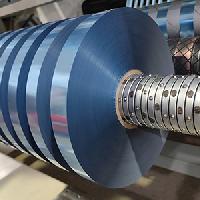Metal foil slitting tool: the application of slitting machine in copper foil and aluminum foil processing

Posted by slittermachine
from the Business category at
09 May 2025 08:23:02 am.
First, special challenges of metal foil slitting
1. Material properties
• Extremely thin and fragile: The thickness of copper/aluminum foil is usually 6-20μm (even up to 4μm for lithium battery foil), which is prone to wrinkles and scratches.
• High ductility: The metal has strong ductility, and it is easy to produce burrs or curls during slitting.
• Electrostatic sensitivity: metal foil is prone to accumulate static electricity, which adsorbs dust and affects the subsequent coating/lamination process.
2. Process requirements
• Dust-free slitting: The dust particle size of the foil for new energy batteries is required to be ≤0.5μm (such as the slitting of the pole piece of the power battery).
• Zero-defect edges: burr height should be controlled at ≤1μm (to prevent short circuit in the battery).
Second, the key technology of metal foil slitting machine
1. Ultra-precision slitting system
• Tool design
• Nano-level cutting edge round knife: diamond-coated insert (3 times longer life) with a cutting edge arc radius ≤ 0.1μm.
• Air Float Support Turret: Reduces mechanical contact vibration and ensures cutting stability.
• Slitting mode
• Non-contact: laser slitting or ultrasonic slitting to avoid mechanical stress (suitable for 4-6μm ultra-thin foils).
• Rolling slitting: cemented carbide upper and lower knife to roll, pressure closed-loop control (accuracy ±0.01mm).
2. Dynamic control technology
• Multi-axis tension control
◦ Magnetic particle brake + tension sensor in the whole process of unwinding → traction → rewinding, with a fluctuation range of ≤ 0.1N.
◦ Taper tension to prevent sliding between foil layers.
• Real-time web correction system
◦ CCD visual detection of edge position, linkage with EPC correction mechanism (accuracy ±0.03mm).
3. Dust-free and anti-pollution solution
• Fully enclosed clean cabin
◦ Maintains micro-positive pressure internally, equipped with ISO Class 5 HEPA filtration.
• Static Elimination
◦ The combination of ionic air rod + conductive brush makes the electrostatic ≤ of 10V on the surface of the foil (new energy industry standard).
• Debris management
◦ Vacuum adsorption + electrostatic dust collection dual system, dust collection efficiency ≥ 99%.
Third, typical application scenarios
1. Lithium battery copper foil/aluminum foil slitting
• Slitting specification: width 100-800mm (suitable for battery pole piece size), speed 60-150m/min.
• Quality Requirements:
◦ No burrs (SEM detects edge roughness Ra≤0.2 μm).
◦ No oil stain (residue <0.01mg/m²).
2. Foil processing for electronic circuits
• High-frequency copper foil: The dielectric loss needs to be stable after slitting (e.g., RTF copper foil slitting accuracy ±0.02mm).
• EMI shielding aluminum foil: avoid lattice damage during slitting and affect shielding effectiveness.
Fourth, intelligent upgrade scheme
1. AI visual quality inspection
◦ In-line inspection systems (e.g., Keyence laser microscopes) identify defects such as pinholes and cracks in real time.
◦ Deep learning algorithms classify defect types (scratches/oxidation points, etc.), automatically mark them, and provide feedback on process adjustments.
2. Digital Twin Optimization
◦ Predict the impact of slitting parameters (e.g., tool pitch, speed) on quality through virtual commissioning.
Fifth, selection and maintenance suggestions
1. Key points of selection
◦ Ultra-thin foil (<8 μm) preferentially selects laser slitting or suspended mechanical slitting.
◦ Winders need to be equipped with surface defect detection (e.g., eddy current sensors).
2. Maintenance is critical
◦ Clean the knife holder and air duct daily, and check the tension system every week.
◦ The blade needs to be polished (or replaced) every 50 km of slitting.
Metal foil slitting machine is developing in the direction of ultra-thin, zero defect and intelligence, especially driven by the new energy industry, nano-level slitting and online quality inspection technology will become the core of competition.
0 Comments



